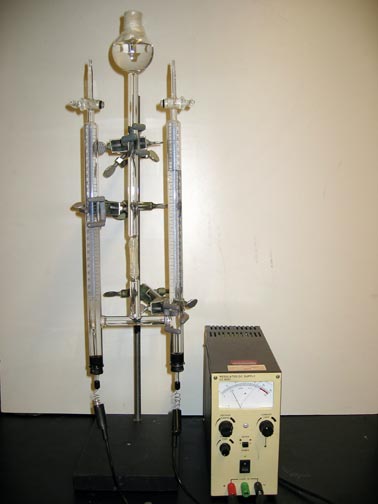Using the electrolysis of water to measure the charge on the electron
 A simple apparatus for performing the electrolysis of water, to create hydrogen and oxygen gases, is used to accurately determine the charge on an electron.
A simple apparatus for performing the electrolysis of water, to create hydrogen and oxygen gases, is used to accurately determine the charge on an electron.
Ingredients: Hoffman electrolysis apparatus, sodium sulfate, DC voltage source with ammeter
Procedure: A complete recipe follows.
1. Prepare a 0.5 M solution of sodium sulfate.
2. Add solution to Hoffman apparatus, leaving room for displacement of solution into the central reservoir.
3. Attach wires to voltage source and tune voltage to achieve 0.25 A current.
4. At the moment that the current begins to flow, begin to measure time.
5. As time passes, gases are collected at each electrode. Stop after 15.0 minutes.
6. Carefully measure the volumes of gas produced at the anode and cathode.
7. Use data collected to compute the charge on an electron.
Understanding: G. Johnstone Stoney began his study of the electron and its properties long before the now more famous experiments of J. J. Thomson and Robert Millikan. Stoney's method for the determination of the electron charge is one that is quite powerful and can be used today to determine the charge on a single electron with little more than water, wires, a battery, and Avogadro's number.
Stoney's method is beautifully simple. He knew that if he inserted two electrodes into a bowl of water, each under an inverted glass, by applying a voltage across the wire he could cause the water to separate into the elemental gases
2 H2O(l) → 2 H2(g) + O2(g)
Moreover, he could collect the pure hydrogen gas, H2, at one electrode, and pure oxygen gas, O2, at the other electrode. By measuring the amount of gas collected, and knowing Avogadro's number, he could determine the number of molecules of water that had been dissociated.What role did the wire play? Why was voltage applied? It turns out that under one glass, there was the reaction
4 H+(aq) + 4 e- → 2 H2(g)
while under the other glass, there was the reaction2 H2O(l) → 4 H+(aq) + 4 e- + O2(g)
If we add these two half reactions together, we recover the overall reaction2 H2O(l) → 2 H2(g) + O2(g)
That is a special sort of electrochemistry that we will study in detail later. For now, we just need to know that the two half reactions can occur in different places as long as those two places are connected by a wire so that the electrons, products in one reaction, can be transported to the other reaction, where they are reactants.
Computing the charge on an electron
Stoney knew that if he produced 2 grams of hydrogen gas,
he had created one mole of hydrogen gas, which was Avogadro's number
of hydrogen molecules. To create one hydrogen molecule, two electrons
had to flow through the wire. Therefore, he knew that
total # electrons = ne
= 2 x number of H2 molecules produced
= 2 x N0 x nH2
nH2 = PVH2 / RT
total charge passed = I x t = ne e
e = I x t / ne
You can do this experiment yourself and find the charge on the electron to be
1.6 x 10-19 C
which is the currently accepted value. It isn't easy to get a more accurate
measurement using this method, but two significant figures is not bad at all!
Stoney did this experiment and arrived at a value for the charge on the
electron of
1.0 x 10-19 C.
Not so great. As a result, when we think of the charge of the electron
today, we think of Thomson and Millikan.
What went wrong for Stoney? It
turns out that his method is just fine, but the value of Avogadro's
number, essential for converting his moles of hydrogen gas into
numbers of individual electrons, was poorly known at the time. The
value that Stoney used was N0 = 1.0 x 1024 mol-1 and that
led to his precise but inaccurate determination of e.
Using the data collected and the method devised by Stoney, compute the charge on a single electron.
You can check your answers here.
Correct your estimate for the charge on the electron, by accounting for the presence of water vapor in the collected gases. Does the correction improve our result, relative to the accepted experimentally measured value of 1.60217646 x 10-19 C?
You can check your answers here.
Computing the charge on a single electron
Question:
The Hoffman apparatus is prepared and run at a temperature of 21.9C and atmospheric pressure of 30.11 inches (of Hg). When 22V is applied to the cell, a current of 0.25 A is created which is allowed to run for 15.0 minutes. During that time, a volume of 28.7 mL of gas is collected at one electrode, and a volume of 14.4 mL of gas is collected at the other electrode.
Correcting the calculation by accounting for the vapor pressure of water
Question:
In the Hoffman apparatus, the gases collected above the two electrodes consist of hydrogen or oxygen gas, and also water vapor. Take the vapor pressure of pure water at 21.9C to be 19.8 mmHg.